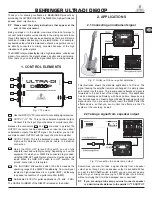
D*AP8
7
Above you see the various function blocks of the audio processor rendered by the
DSP
engine.
Each function block has its representation in the GUI by individual tab sheets. You may simply click on the
respective graphical area as an alternative way to navigate through the GUI.
It is important to understand that the physical input interfaces of the device (SDI DE-EMBEDDER, AES IN)
must be routed to the
DSP
inputs in order to process it. Similarly the
DSP
outputs must be routed to output
interfaces (SDI EMBEDDER, AES OUT). You will find those settings by clicking on the
ROUTING
tab.
For additional functions like FM-processing or watermarking, one may buy a co-processor module JDSPA.
It must be routed into the signal paths as well.
Control concept
The communication between the
X*AP RM
1
remote panel, the
D*AP8 unit
, setup and operating tools, is
based on
TCP/IP
over
Ethernet
.
The setup GUI utilizes web technology. At the time of editing this manual the functionality of the web GUI is
optimized for Firefox 35.x and higher.
The setup GUI can be complemented by other application programs running on MS Windows
®
XP, W7, W8
like the Junger Application Manager
J*AM
. Operator access will also be available for mobile devices running
an appropriate browser on iOS or Android.
An
SNMP
agent is also available on the device and may be explored via a SNMP monitoring system.
For
3
rd
party
remote control
Junger highly recommends using the l-s-b
EmBER+
protocol which is widely
distributed in the European broadcast industry. The user community is also increasing rapidly world wide.
By default, the
X*AP RM
1
remote panel and the
D*AP8
"talk" Ember natively.
Operating concept
Further below you will see that the setup GUI for the device is grouped into several parameter areas.
One can reach the parameters via a 3-tier navigation via tabs which may have sub tabs and sub tabs may
have pages embedded or extra soft buttons for groups of parameters.
Each function block (parameter area) has dedicated presets. The presets can be recalled at any time during
operation, either by manual intervention via the embedded web server (browser based GUI), automatically
by the internal event manager or by external applications.
For all relevant settings an
ON AIR
and a
PRESET
part exists. I.e. you may either edit the parameters
ON AIR
or
offline
for the respective function block of the
D*AP8
.
The presets of the
D*AP8
are persistent by nature. You are working directly on the preset memory.
I.e. you must not worry about storing such presets. The
D*AP8
does it for you.
Event concept
The
D*AP8
incorporates a sophisticated event management system.
Events may be combined to perform actions. The
D*AP8
offers these event types:
*
Preset Events
for System set-up, Interfaces, Routing, Audio Processing, Dolby related settings etc
*
Parameter Events
*
Measurement Events
for pre-configured measurement scenarios
*
I/O Events
for GPOs
*
Bypass Events
These events may be combined with
Actions
which are fired by
Triggers.
Trigger
s are defined by a logical combination (AND, OR, XOR) of two random trigger sources.
A trigger source may be GPIs, hotkeys of the
X*AP RM
1
remote panel, network commands, parameters,
other active events, other active triggers (nested trigger), or device status information (e.g. sync lost).












































